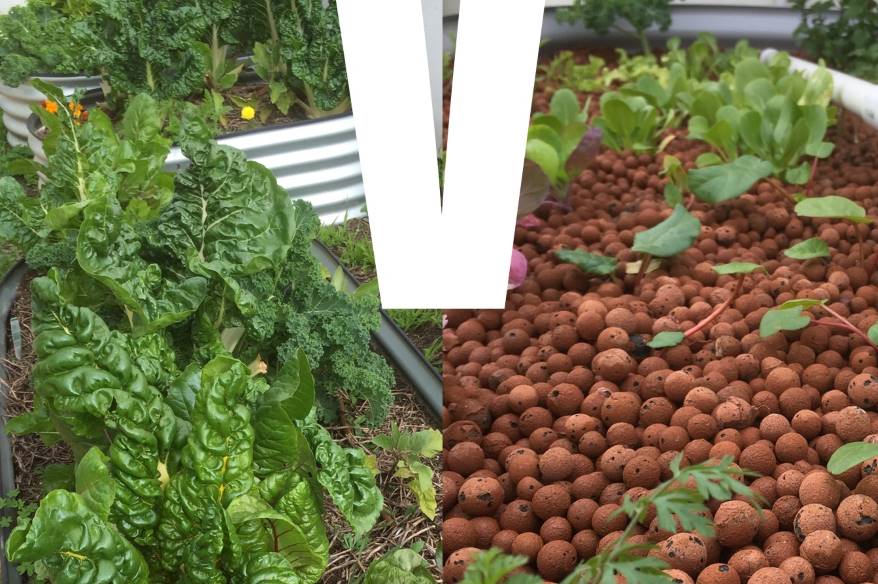Blessings and Love!! For anyone who has even a fleeting interest in aquaponics will at some point ask, what is the difference growing in Soil/Traditional Agriculture verses growing in an Aquaponics system? Are Bigger Purpose Built Farms better than Backyard Farming?
I thought I would discuss some of the “not well known” areas of these different ways of growing both Commercially and At Home aside from crop taste, growth, production and form.
SOIL GROWN (or traditional grown vegetables) are obviously a very successful and easily accessible way to garden and grow your own food, it can be relatively inexpensive in comparison to an Aquaponics set up and of course its capable at a basic level knowledge wise. Vegetables grown in Soil rely on the various nutrients in the soil for plant growth and success, along with the Soil’s Microherd (Microbiology). Amendments and Fertilizers are relatively inexpensive and mostly seen as harmless.
AQUAPONICS GROWN on the other hand is the combination of Hydroponic plant growth and Aquaculture. The plant growth takes place with no soil, but rather an Inert Media usually made of either Perlite, Coco Coir, Vermiculite and Expanded Clay or a mix of all. The plants rely on the production of fish waste which is cycled through the grow beds for their nutrients (Macro/Micro/Major etc), and in return they filter the water for its return to the fish tank to start again.
THE SUSTAINABLE ENVIRONMENTAL IMPACT OF SOIL GROWN can be somewhat seen as a good, safe and healing alternative with a concentration back on Organic Soil Growing Methods, but a lot of farmers do not use these methods for Commercial Production and Sustained Production Quality. Soil Tilling and other noxious methods for Production and Cultivation are employed, with emphasis on Return of Investment and Profit over Soil Health and Earth Care. Even the overuse of Organic/Livestock manures and fertilizers can have a massively negative impact with Nitrogen Dioxide Release similar to Methane but potentially worse long term as it is considered less harmful.
Two Part explanations as I can see it.
Cost of Production and Return on Investment/Profits. For us home gardeners it’s very easy and affordable to grow Organic. We buy a few bags or trailer load of amendments, and we are off and growing again. At some points, it may be expensive for some particular amendments, but since it’s a small area, a premium price is easily accepted. But try that over a 100-acre Broadacre Farm and the Cost and Return change dramatically. I have asked many farmers over the years and for some, it’s just not a viable way for them to make money, or should I dare say, the money they and linked businesses are used to. It would be good to see these farmers Invest Back in their Farming Land and Biology and grow for Generations more Symbiotically with Nature.
THE SUSTAINABLE ENVIRONMENTAL IMPACT OF AQUAPONIC GROWN is well documented, it takes up less space to grow significant amounts of vegetables and fish sometimes reaching over 10X the same amount of veg grown per m2 as in Soil Grown. It does not utilise as much of the earths soil consistently compared to Soil Growing, but, on the other hand, building and construction of these farms can be an environmental disaster for the surrounding life and waterways. Some poorly built (in terms of environmental awareness and security) gigantic farms covering over 10km2 plus, can devastate land, water, and life. Salt and Petroleum Based Fertilizers and Pesticides/Herbicides are often overused and when the time is up, just like Mining, leave the degraded land after, minimising life and slowing the returning of life. Growing can take place almost anywhere inside or outside. The Electricity and Water needed is quite expensive, but with new technology coming forward, things are changing. For the better or worse? The tech side of this industry is seen as a blessing as the costs of electricity are coming down for farmers with “Sustainable Energy Systems” but to create that tech and the energy/resources and money, is an industry unto itself. Both Soil and Alternative Farming Tech development is very costly. Just as much as there are some mean ugly farms, there are also some new ventures with some very elaborate and interesting systems set up around the world showcasing sustainable aquaponics.
Which Option is Best? Well – sad to say, there is no hard and fast rules here but some vegetables are more suited to Traditional Soil Gardening (particularly soil loving root veggies like Carrots, Potatoes & Beets) while Leafy Greens, Tomatoes, Cucumbers and other above ground growers tend to grow stronger in Aquaponics systems, feeding off the fish nutrients and constant water supply – but the best thing about gardening is try for yourself and see what works for you and your needs. This goes for both Commercial and At Home Gardening.
Everyone has different Garden Soil Types so making sure you get the Nutrients/Soil Microbiology balance right and keeping it there is important while with aquaponics it is a matter of getting the Fish/Bacteria and veggie balance correct and the watering takes care of itself but of course can be affected by mechanical pump breakdown and power outage. Knowledge is Key. Suburban Farmer offers coaching in both Soil Growing and Aquaponic Growing.
Aquaponics systems, you will generally find, produce veggies that continue to thrive and grow for longer than outside seasonal growth, when the nutrients levels, light and space are correct, giving you more veggies more often, for longer. Some plants can grow upwards of 10X their relative outside soil grown versions.
Insect attacks do seem to happen more often in soil-based gardens, mostly because they are at a lower level and more accessible to pests and of course everything is growing in super awesome organic soil that insects love as much as your veggies. Aquaponics are not immune, nor greenhouse/hoophouse exclusions. Aquaponic grow beds are generally much higher from the ground so fare much better against insect attack, short term. We still need our Beneficial Garden Protectors and Pollinators so their can be an imbalance just the same as Soil Grown Outside Gardens.
SO WHERE DOES THIS LEAVE YOU– well each to their own as they say – but I personally think a good mix of both farming options are going to allow you to produce longer and stronger throughout the year and also make gardening a lot of fun with the different science to each gardening style and you get to watch your fish as well as your vegetables grow in the best environment possible for your situation.
WHAT IS THE SOLUTION? Backyard Gardens, Self-Reliance, Veganic Soil Growing (Stock Free Natural Plant Based Growing, with an emphasis on supporting Microbiology), Organic Aquaculture/Aquaponics, Collective Biospheric Consciousness or as we Ratsa say, Natural ITAL (Vital Conscious Earth Grown) Livity with Oneness. We don’t need massive, consuming areas of land specific for farming, moving out endemic flora and fauna for food growing. If we each had a small plot in our own yards or allotment’s, commUNITY Gardens and the likes, then not just land, flora and fauna are protected, but a whole heap of fossil fuels and food miles/km’s, energy input and expenditures, waste products etc are kept from mashing up the Biosphere and Terrestrial/Subterranean life. Might be less profits for companies, but we will have a better life for ALL.
Ras Mark SUBURBAN FARMER.

